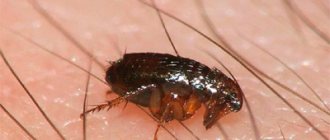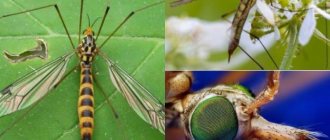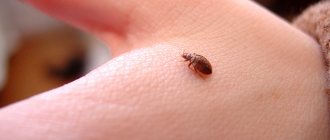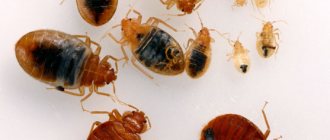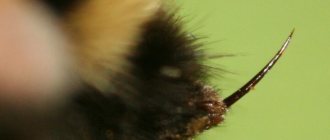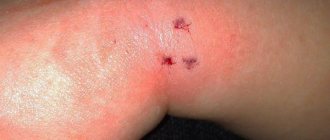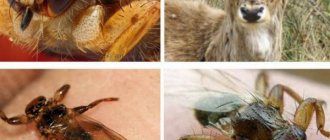- Types of fleas that attack people
- Symptoms of flea bites in a child
- How dangerous are flea bites for a child?
- Drug treatment of flea bites in children
- Traditional medicine methods
- How to reduce pain from bites
- Activities to help prevent flea bites
- Fighting parasites in the apartment
Flea bites in children are painful and often cause an allergic reaction. Scratching wounds is dangerous due to secondary infection and the appearance of pustular rashes that develop into pyoderma and ulcers. Let's consider what to do if fleas have bitten a child, what to apply and how to treat.
Types of fleas that attack people
These blood-sucking parasites are found throughout the world. There are more than 2,000 species of fleas, and all of them are dangerous to humans. Of these, the most common are:
- Feline. In cities where cats are usually kept in apartments, these insects are rare. They infect animals in rural areas where cats run outside.
- Canine. Dogs regularly go outside for walks, where there is a high risk of parasite infection. Bloodsuckers pass from them to children.
- Rat. Parasites enter the apartment from the basements where rodents live. The danger of these insects is that they carry serious diseases. If a child is bitten by rat fleas, he is immediately shown to a doctor to prevent infection.
- Human. These fleas attack people and animals. They prefer children who have delicate and thin skin. Insects move easily in the hair, but after drinking blood, they leave the person. The parasites' bites are painful and they are very difficult to catch as they jump long distances. Usually insects settle in human dwellings, where they hide in secluded places.
Typical lesion sites
Fleas do not live on people. They prefer more secluded places, for example, cracks in the floor, carpeting, and upholstered furniture. Insects actively settle on domestic animals, where they are attracted by the shelter in the form of fur and the warmth emanating from the body of a cat or dog. The temperature of the human body is too low for fleas, and there is nowhere to hide, so the parasites appear on people for a short time, only to feed.
Since fleas cannot bite through clothing, bites are most often localized on those places on the body of a child or adult that are not covered by clothing - legs, arms, and less often on the face, stomach and lower back. Fleas feel quite comfortable under the cover of hair, so they can be found on a child’s head. Unlike lice, which live in hair, fleas stay there for a short time, constantly jumping from one place to another.
Symptoms of flea bites in a child
Fleas do not live on humans. These parasites attack people, pierce their skin with sharp jaws and drink blood. Having had enough, they jump off the victim’s body and hide in secluded places: under baseboards, in carpets and in upholstered furniture.
Parasites spread eggs throughout the house. Hair-covered larvae, nymphs, quickly emerge from them. They feed on organic debris and are often concentrated near the trash can. After 2 weeks, the larvae turn into adult insects and attack people and animals.
The signs of a flea bite in children are pronounced, unlike in adults. A blister up to two centimeters in diameter appears at the site of the bite. There is bruising under the skin and severe swelling around the blister.
Parents do not always understand that their child is being attacked by fleas and confuse their bites with mosquito bites. But flea bites have their own characteristics.
- Bites are concentrated on one area of the body. Most often they appear under the hair, on the legs and arms.
- A dense red spot appears around the bite, and in the center there is a blister filled with liquid.
- Children experience severe pain when fleas bite them.
- If you carefully examine the affected areas, you will see wounds through which the parasites sucked blood.
It is impossible to see jumping insects in a child's head; they do not lay eggs in the hair. But if the baby constantly scratches his head, and inflamed blisters are visible on the skin under the hair, then these are signs of a flea attack.
Babies who have been bitten by parasites complain of itching and pain. Their wounds become more inflamed than those of adults. Parents should immediately pay attention to the child’s complaints and find out their cause, because we are talking about the baby’s health.
If a child is attacked by bloodsuckers, take the following measures:
- relieve pain and itching in the baby, treat wounds from bites;
- destroy multiplied parasites in an apartment or house.
In the future, in order not to miss the appearance of bloodsuckers, the child’s legs, arms and head are carefully examined, and the hair is combed out with a fine comb.
Fleas bite children all over their bodies, since the skin is delicate and it is not difficult to bite through them. The itching from the bite is unbearable.
After the rash appears, the lymph nodes become enlarged. Some children have increased body temperature and stool upset. If such symptoms occur, you should contact your pediatrician.
If an infection is suspected, the doctor will give a referral for a blood test, since the composition of the blood plasma changes with repeated bites.
Why is the danger of flea bites greater for children than for adults?
- A child’s skin is thinner and more vulnerable – so a flea bite is especially painful, it can be scratched and does not go away for a long time.
- Children are prone to allergies because... their immune system is weaker than that of an adult.
- The flea is a carrier of infections and eggs of most helminths (we talk in more detail about the danger of fleas to humans here).
How dangerous are flea bites for a child?
Flea bites on children's skin do not heal for up to 7 days. They cause hives, inflammation and other allergic reactions. In severe cases, the child develops Quincke's edema and anaphylactic shock, and multiple bites lead to bronchial asthma.
Children often scratch bite marks, causing dirt to become trapped in them. This leads to purulent inflammation. Parasites cause pulicosis in children, which is characterized by the following symptoms:
- temperature rises;
- lymph nodes swell;
- diarrhea appears;
- the child feels weak and has difficulty breathing.
- wounds form on the mucous membranes.
If these signs appear, you should consult a doctor immediately.
Another danger of parasites is that they are carriers of pathogens of serious diseases:
- encephalitis;
- brucellosis;
- typhoid fever;
- tularemia and others.
The saliva of bloodsuckers contains many bacteria and helminth eggs, which can be transmitted to children.
If a child is bitten by one or two fleas, this does not mean that he will definitely get sick. But when insects appear in a house in large numbers, the risk of infection increases significantly.
What infections can fleas carry?
At first glance, point parasites, in addition to discomfort and unpleasant sensations, do not bring any harm to humans. But that's not true.
Important! In addition to irritating bites and allergies, fleas pose a serious threat to human health.
Small insects enter a residential building from basements and dirty areas of the streets. Bloodsuckers huddle in damp and dusty places where rats and mice infected with viruses and infections live.
Attention! Moving from the habitat of bacteria to human skin, fleas become spreaders of serious diseases. The main culprits of the mass epidemic are small parasites that are not so often noticed by adults.
With the appearance of blood-sucking insects, the inhabitants of the premises are at risk of diseases such as:
- Salmonellosis.
- Plague.
- Typhus.
- Encephalitis.
- Trypanosomiasis.
- Anthrax.
- Tularemia.
- Fungal infections.
- Listeriosis.
In addition, fleas are carriers of helminthiasis. They increase the likelihood of a child becoming infected with worms and intestinal infections.
Attention! Insects are dangerous even when crushed. Together with a toy or other object, a baby can pull an immobilized insect into his mouth, allowing a source of bacteria and microbes into his body.
Drug treatment of flea bites in children
If flea bites are found on the baby’s skin, treatment begins immediately. If there is an allergic reaction, the pediatrician will prescribe allergy medications. Take them according to the recommendations, without exceeding the permissible dosage.
The wound is first washed with water and treated with disinfectants. The water should be cold so as not to increase irritation from the bite. Hydrogen peroxide, Chlorhexidine or Miramistin are suitable as an antiseptic.
Itching is relieved with a cotton pad soaked in a soda solution. Apple cider vinegar relieves the burning sensation.
Flea bite wounds for children are smeared with the following products:
- Boro-plus;
- Antiallergic gel Fenistil;
- Bepanten;
- Calamine lotion:
- Psilo-balm;
- Nezulin.
Before using medicinal balms, lotions, creams, the child is checked for an allergic reaction. First, the product is applied to the baby’s wrist. If redness is not observed, the drug can be used.
Possible complications
Inflammation of the lymph nodes in a child
Children's bodies are especially susceptible to flea bites, so the skin reaction can be unpredictable. The development of complications can be determined by the following symptoms:
- increase in body temperature to +37…+38 °C;
- inflammation of the lymph nodes;
- problems with stool (diarrhea);
- severe allergic reactions (up to anaphylactic shock).
The most common complication is an allergy to flea bites. It develops for the following reasons:
- During a bite, the insect injects an enzyme that prevents blood clotting. The enzyme contains proteins that cause the development of allergic reactions.
- The child’s immune system is in the formative stage and cannot withstand negative external factors.
- Delicate skin is especially sensitive to insect bites.
If a child scratches the bites, wounds appear in their place, through which microbes enter the body. Parasites carry plague, typhoid, hepatitis and other dangerous diseases. There are known cases of fleas infecting children with helminths.
A child who has been attacked by bloodsuckers must be closely monitored. Even a slight increase in body temperature may indicate the presence of an infectious process in the body, so if any unusual symptoms appear, you should contact your pediatrician. After a thorough examination, the patient will be prescribed adequate therapy.
Traditional medicine methods
Traditional medicine recipes will help cure flea bites in a child.
A mixture of dandelion juice, parsley leaves and plantain relieves inflammation well. Add a grated clove of garlic to the juice and apply the mixture as a compress to the wounds. The procedure lasts 20 minutes, after which the compress is washed off from the skin.
A solution of ammonia will help relieve itching. Dissolve 5 grams of soda and 5 ml of ammonia in 200 ml of water. The compress is applied for 10 minutes. If the child complains of a burning sensation, the bandage should be removed from the skin.
If there are a lot of bites on the child’s body, they are lubricated with a mixture of honey and lemon juice. To do this, dilute 5 grams of honey in 100 ml of lemon juice. Apply the product to the skin with a cotton swab and wash off after 10 minutes.
If a child scratches the wounds, they are dried with brilliant green or sulfur ointment. To prevent repeated scratching, the bite sites are secured with a bandage.
Why is this so important?
As a rule, the allergen is eliminated from the body on its own after two to three days. But! The rash may be the start of a more serious allergic reaction. The main symptoms are:
- enlarged lymph nodes;
- temperature rise to 38-39°;
- swelling, nasal congestion;
- diarrhea.
Severe itching makes the baby restless and he begins to scratch the bites, increasing the risk of infection.
If flea bites cause severe allergies, you should not take it lightly, leave the situation uncontrolled, or self-medicate. Only an immunologist will prescribe competent treatment and select medications individually for your baby.
Eliminating the causes of the disease is the best prevention.
We told you how to recognize flea bites in children and how to eliminate unpleasant consequences. But, of course, the best prevention is the absence of insects in your home!
How to reduce pain from bites
To relieve itching and inflammation in the affected areas, use the following remedies:
- the wound and the aureole around it are lubricated with hydrocortisone or other medicinal ointments;
- apply hot and cold compresses to relieve pain;
- inflammation is relieved by baby lotion, a mixture of tea tree and almond oils;
- itching is reduced by warm water, to which a teaspoon of soda and ammonia have been added.
If complications arise, consult a doctor for treatment with antihistamines and sedatives. To repel fleas from the scalp, take the following measures:
- Wash your hair and scalp with tar soap. Its smell cannot be tolerated by parasites.
- The affected areas are treated with brilliant green or hydrogen peroxide.
- Aloe juice, which is applied to the scalp, helps against parasites. This remedy repels fleas and heals wounds.
First aid
Tavegil
If your child is bitten by fleas, wash the wound with cold water and antibacterial soap. If you are allergic to bites, you should use any antihistamine. Suitable for treating children:
- Diprazine.
- Fenistil.
- Diazolin.
- Suprastin.
- Tavegil.
Before giving medicine to a child, you need to read the instructions, which indicate at what age the drug can be taken.
Flea bites can be lubricated with the following products:
- ethyl alcohol or vodka;
- baking soda solution;
- Sulfuric ointment;
- calamine solution.
If a child scratches the skin, the wounds should be treated with brilliant green or iodine. If desired, you can use pharmaceutical ointments (Nezulin, Bepanten or Psilo-balm). To prevent further scratching, the treated areas are bandaged.
If the itching does not subside, the affected areas of the body can be immersed in very cold water. If the bites are located in hard-to-reach places, apply ice or frozen meat. If necessary, make a compress of 1 tsp. baking soda and 1 glass of water (helps relieve itching).
Activities to help prevent flea bites
Carrying out preventive measures will help prevent the occurrence of bites in children.
So what to do:
- If there are animals at home, flea products in the form of drops and shampoos are constantly used. Dogs and cats are given a therapeutic collar.
- Any contact of a child with homeless animals from the street is prohibited.
- For preventive purposes, once a month the apartment is treated with products that repel fleas.
If suspicious symptoms appear, you should contact your pediatrician. Self-medication is categorically unacceptable in the case of young children.
Fighting parasites in the apartment
To get rid of parasites, animals in the house are treated with insecticides. They are washed with flea shampoo, treated with sprays and put on flea collars.
In all rooms, floors are washed, carpets and upholstered furniture are vacuumed, floors and walls are treated with aerosol insecticides or dust is spread. Mattresses are sprayed with insecticides and bed linen is changed. If fleas enter an apartment from the basement or attic, they contact the sanitary and epidemiological station to destroy them.
To prevent re-infestation by fleas, preventive measures are taken:
- The child is regularly examined to detect parasites in time.
- Bed linen is changed frequently.
- Pets are removed from the children's room.
- The child is not allowed to communicate with stray cats and dogs, or to pet or hug them.
If flea bites are found on the baby’s skin, then urgent measures are taken to get rid of the bloodsuckers, otherwise they will quickly multiply in the house. The apartment and the pets living in it are treated with anti-parasite agents. Bite wounds are lubricated with medicinal preparations, and the head is washed with tar soap.
